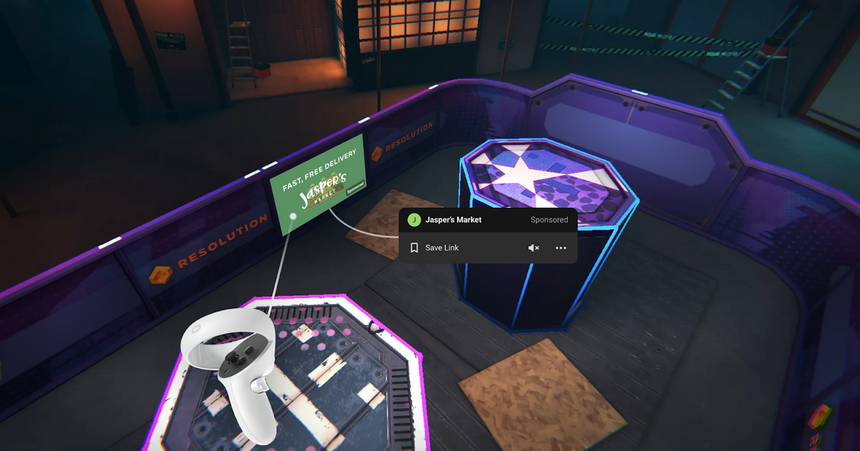Yesterday, Facebook took a leap many people have been predicting for years: it started putting ads inside virtual reality. The company launched a limited test of advertisements inside three Oculus Quest apps, saying it would expand the system based on user feedback. The move is a turning point for Oculus, bringing one of Facebook’s most controversial features into a medium that inspires both idealism and alarm. And it raises three big questions about Facebook’s future and immersive computing.
The first question is how deeply Facebook will end up linking advertising with hardware sensor data. Even more than smartphones, Oculus Quest headsets are a gold mine of information about you. They capture precise head and hand motion, pictures of your surroundings through tracking cameras, and microphone audio for Facebook’s voice command system. Future headsets will likely include even more intimate features like eye tracking, which would offer incredibly precise metrics on what captures your attention in VR.
Right now, Facebook says much of this data either never leaves your headset or is completely segmented from its advertising system, and it says it has “no plans” to do things like target ads based on movement data. But as Facebook moves deeper into virtual and augmented reality, using its hardware’s special features for advertising will become an increasingly attractive prospect.
Immersive computing is a gold mine of intimate data
Facebook is reportedly working on a fitness tracker and has discussed building AR glasses that you’ll use to interact with the world. These products are custom-built to produce quantifiable insights about your body and surroundings, and it’s hard to believe Facebook doesn’t have plans to monetize that — even if Facebook Reality Labs head Andrew Bosworth has said the company is “not really focused on business model” questions for experimental hardware. Oculus is Facebook’s first big test case for advertising on its own computing device, and as it expands ads on VR and other hardware, we’ll see how it handles the wealth of new data types it’s collecting.
The second question is how ads will affect VR development. Several of the bestselling VR titles right now feel like substantive console or PC games and sell at a similar price. By contrast, it’s not yet clear which app genres work well with an ad-based model. (Blaston, the first game we know includes ads, is a multiplayer dueling game that you play in short competitive bouts.) Whatever those genres are, Facebook just created an incentive to make a lot more of them, since developers get a cut of the revenue involved.
It’s easy to imagine dystopian scenarios like a huge library of attention-grabbing but low-quality games and social apps plastered with pop-ups, or the seizure-inducing corporate hellscape from Ready Player One. It doesn’t help that Facebook’s first tests look like flat banner ads from a website or freeware game. That said, Facebook is notoriously picky about what goes into the Quest library and there’s no indication that will change soon.
We also don’t know VR advertising’s final form. Facebook says it’s currently exploring “new ad formats that are unique to VR.” It didn’t specify what that looked like, but for one nontraditional ad platform, we could look at Fortnite — a popular virtual world from a studio with an impeccable gaming pedigree, and one of the most effective ad delivery systems in the modern cultural landscape. (A system where players pay to promote the intellectual property of multinational media conglomerates is possibly also dystopian, but in a way most people seem okay with.) Modern consumer VR headsets have been full of ads since practically the beginning, thanks to promotional tie-ins and sponsorships. Yesterday’s news was just the latest iteration of a long-running trend.
What does a good ad-supported VR app look like?
This iteration, though, has a big Facebook-shaped wrinkle. The Quest ads are served based on data from your Facebook profile, and Facebook’s hyper-personalization is one of its most controversial features — criticized in general as a tool for social division and more specifically for enabling discrimination. Beyond any larger social effects, if you’re sharing a headset with friends and family, it could feel simply invasive to have them see what Facebook thinks you’re into. You can add multiple accounts to a Quest headset, but the feature is experimental and it’s not clear how many users know about it.
And that raises the third question: how will Facebook and its critics address general concerns about “Big Tech” in the realm of VR? Should Facebook, for example, ban specific kinds of ads — or methods of ad delivery — from appearing in headsets? And should consumer protection watchdogs look specifically at how ads work inside the Oculus platform, which they’ve largely ignored when scrutinizing Facebook?
It wasn’t hard to see these debates coming. Facebook has wanted to own the next computing platform for years, and its vision of computing relies a lot on advertising. Oculus founder Palmer Luckey once promised that Oculus wouldn’t “flash ads at you” inside VR, but he (along with Oculus’ other early executives) left the company years ago. Bosworth said in 2015 that the Oculus experience “should include ads, because life includes ads.”
But Facebook says it’s not just barreling ahead with a long-held master plan — instead, it promises it’s looking at feedback as it moves forward with VR advertising. As VR gets closer to Facebook’s core business, Quest users and developers will get to see if the company keeps that promise.

